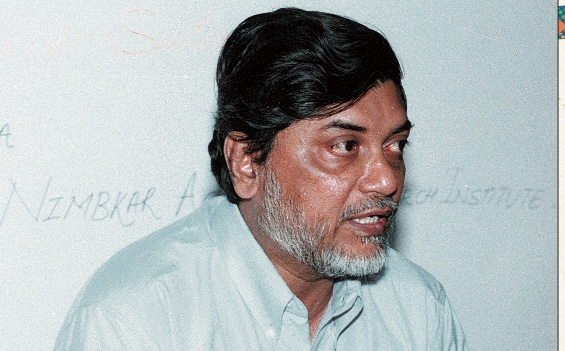By Tirtho Banerjee
Anil Rajvanshi goes out of his way to make out-of-the-ordinary things. He was the first to use space-shuttle technology on lanterns. He was the first Asian to extract ethanol from sweet sorghum using a solar distillation plant, a feat so innovative that the US National Academy of Science took notice. He pioneered a solar-powered desalination plant and developed India’s first battery-operated cycle rickshaw for transporting people or goods. In 2001, he was the first agricultural scientist to receive the prestigious Jamnalal Bajaj International Award for his contributions to science and technology in rural development.
Rajvanshi graduated from IIT, Kanpur, in 1974. Then, with a government scholarship, he went to the US for a PhD in solar energy. He taught at the University of Florida where he met his wife Nandini. Both crystal clear about what they wanted to do, they returned to India in 1981, despite repeated pleas from their American colleagues to stay in the US. “I believe in the Indian philosophy firmly,” said Rajvanshi. “So does my wife. And for seven years after our marriage, while we were in the US, we refrained from having a child because we did not want our child to grow up in that atmosphere. I came back to India because I wanted to help improve the lives of the people in my homeland with my knowledge.”
He set up shop in Phaltan, near Pune, at the Nimbkar Agricultural Research Institute (NARI), which was supervised by his father-in-law. It wasn’t long before he tackled a nasty problem that everyone lived with: villagers, not privy to electricity, had just kerosene lanterns of poor quality. Anil explains, “The wick of the lantern burnt, charred and was inefficient. I changed the wick and coated it with thermoluminescent salts which glow when they get hot. I found silica cloth most suited for the lantern and used special glass to reduce the chances of explosion and to brighten the light.” He called it a Noorie lantern (after his eldest daughter). It gave six to seven times more light than the common hurricane lamp. Posted by Anil on the internet, the Noorie attracted numerous clients from as far as Sussex and the US. For those outside India, lamps sell for us$25 plus shipping.
Rajvanshi didn’t stop there. He also invented a home-brewed replacement for that sooty kerosene–ethanol alcohol distilled from sweet sorghum using solar energy. His small plant produces 13.2 gallons of ethanol each day. Sorghum is a common, versatile crop that here provides grain and sugars for eating and for fuel. Presently the Nimbkar Institute has around 25 sorghum varieties. Their sweet sorghum hybrid, “Madhura,” named after Rajvanshi’s second daughter, has been tested in Thailand, Zimbabwe and Southern France. The syrup from sweet sorghum has turned out to be a hit in Pune and Mumbai.
Rajvanshi also developed a simple, solar-charged, safflower petal collector, carried on the collector’s back, that radically speeds up the picking process. The petals and flowers are used to make an herbal tea which is sold in Pune.
With his influx of genius, NARI has undergone major changes. Rajvanshi’s magic touch can be seen everywhere in landmark techniques for renewable energy and agricultural research. Among his most significant innovations is a device for extracting water for plants in arid wastelands. “We use the heat of solar radiation to free the water bound in the dry soil and use it for irrigation. The method is simple. Dig a pit about 24 inches deep. Cover it with a solar-water evaporation still with reflecting sides and a sloping glass roof. The water evaporates and condenses into droplets on the glass roof and collects in a bottle or cup attached to the sloping roof.” The water is then fed to the plants right next to the water collector. His collector produces about 1.25 cups (300 ml) of water a day–enough for four plants to get started. Once plants are established, the still is moved to another location to start new plants. Each solar still costs less than $12 to build.
What else? Solar desalination. Anil’s system uses wind turbines to pump cold seawater ashore in plastic pipes. The water is then heated using solar energy. Voila, the steam condenses into dew and is collected: a perfect system for the desert regions of India.
For the last three years, Rajvanshi has been revolutionizing India’s omnipresent cycle rickshaw. He has developed three versions. First is an improved pedal cycle that is so efficient that a rickshaw driver can carry two passengers on a six to ten percent slope quite easily. It is designed so that the driver also has enough space to sleep comfortably. Model two is a motor-assisted cart that can carry loads at speeds of six to nine miles per hour. The last and most innovative version, called elecsha, or electric rickshaw, runs on batteries, has a five-speed gear system, backwheel braking, more convenient seating arrangement and better dynamics than India’s current rickshaws. All three are efficient, economic and most importantly belch no smoke and make little noise. Five of Anil’s rickshaws are being run at the University of Pune as a practical demonstration arousing great interest. A company in Pune has agreed to mass produce them.
“I have been tremendously influenced by the great spiritual traditions of Vedanta,” said Rajvanshi in an interview with Hinduism Today. “Personally, three great personalities have influenced me: Patanjali, Ramakrishna and Vivekananda. I consider the ancient Indian philosophical thought as a great contribution to mankind. The great thoughts of mankind are universal in nature and are not bound by caste, creed or nationality. They are a celebration for mankind.”
Nimbkar Agricultural Research Institute (NARI), Phaltan-Lonand Road, Tambmal, P.O. Box 44, Phaltan 415523, Maharashtra, India. phone: 91.2166.22396. fax: 91.2166.21328-email:anilrajvanshi@vsnl.com.
